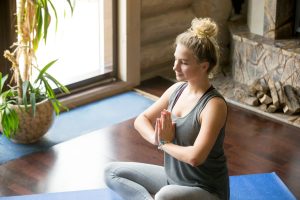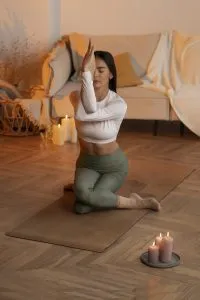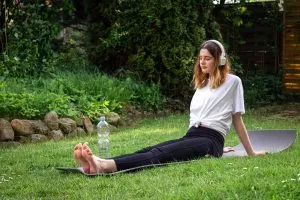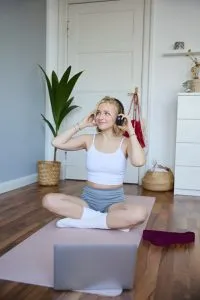Take a deep breath. No, really—do it. Feel your chest rise, your belly expand, and the quiet pause before you exhale. That simple act? It’s more powerful than we often realize. In yoga, that breath is more than just a biological necessity—it’s a bridge. A bridge between body and mind, between stress and calm, between movement and stillness.
In this post, we’re diving deep into the transformative world of breathwork in yoga. Whether you’re a yoga instructor, a seasoned yogi, or someone navigating health challenges, learning to harness your breath could be the most important pose you ever master.

Why Breathwork in Yoga Matters
I used to think yoga was all about how flexible I could get. I spent months chasing that elusive full wheel pose. But the real transformation didn’t come from stretching deeper—it came the day I finally slowed down and tuned into my breath.
Breathwork in yoga, or pranayama, isn’t just about breathing. It’s about directing life force, or “prana,” through conscious breath control. This ancient practice is a key limb of yoga and often overlooked in favor of flashy poses.
But here’s the thing: Without breath, yoga is just stretching.
Let’s explore the power behind the inhale and exhale, the techniques to get started, and the incredible pranayama benefits that follow.
What Is Breathwork in Yoga?
Breathwork in yoga, also known as pranayama, stems from two Sanskrit words: prana (life force) and ayama (to extend or control). So pranayama quite literally means to expand or control your life force.
In a yoga class, you may hear cues like “inhale to lift” or “exhale to fold.” But pranayama goes deeper than syncing breath with movement. It’s about mastering the breath itself, often practiced before or after asana (poses), or even as a standalone meditation.

The Science-Backed Benefits of Pranayama
Modern research has caught up with ancient wisdom, and the benefits of breath control in yoga are impressive:
- Reduces stress and anxiety (source)
- Lowers blood pressure and heart rate
- Improves respiratory function, especially in asthma and COPD patients
- Enhances sleep quality and emotional regulation
- Boosts focus and cognitive clarity
- Supports digestion and immune health
I personally found my anxiety levels dropped drastically when I added 10 minutes of alternate nostril breathing to my morning routine. No meds, no apps—just breath.

7 Yoga Breathing Techniques to Explore
You don’t need to master them all at once. Think of these as tools in your yoga toolkit. Start with one or two and notice what resonates.
1. Ujjayi Pranayama (Victorious Breath)
Also called “ocean breath” for the soft, wave-like sound it makes. Slightly constrict your throat and breathe in and out through your nose.
Best for: Focus, calming the mind, flowing in vinyasa.
Try this: Imagine fogging up a mirror, but with your mouth closed. That gentle rasp? That’s the Ujjayi whisper.
2. Nadi Shodhana (Alternate Nostril Breathing)
This classic technique balances the left and right sides of your brain. Use your fingers to close one nostril at a time, alternating the inhale and exhale.
Best for: Reducing anxiety, balancing energy, pre-meditation.
Tip: It’s like giving your nervous system a gentle reboot.
3. Kapalabhati (Skull-Shining Breath)
Forceful exhalations through the nose, passive inhalations. This energizing practice clears the mind and tones the abdomen.
Best for: Morning wake-up call, detoxifying lungs.
Note: Avoid if pregnant or have high blood pressure.
4. Bhastrika (Bellows Breath)
Similar to Kapalabhati but with both inhalation and exhalation forceful and active.
Best for: Boosting vitality, warming up the body.
5. Bhramari (Bee Breath)
Hum like a buzzing bee as you exhale. This vibration soothes the nervous system and quiets the mind.
Best for: Insomnia, migraines, tension release.
6. Dirga Pranayama (Three-Part Breath)
Breath fills your belly, ribcage, and chest. This is foundational, calming, and deeply restorative.
Best for: Beginners, stress relief, gentle centering.
7. Box Breathing (Four-Part Breath)
Inhale, hold, exhale, hold—each for the same count (e.g., 4 seconds).
Best for: Focus, managing overwhelm, meditation.

Integrating Breath Control in Yoga Practice
A lot of us move through yoga classes on autopilot. We hear “breathe deeply,” and maybe we do—for one or two breaths. But weaving yoga breathing techniques throughout your entire practice transforms it.
Breath as Your Inner Teacher
The breath tells you more than a mirror ever could. Is it shallow? You might be forcing. Is it rapid? Maybe it’s time to pause. Steady and smooth? You’re right where you need to be.
When I teach, I often cue students to “let your breath lead your movement.” Not the other way around. Movement becomes an expression of the breath—and that’s the sweet spot.
Breath in Daily Life
You don’t need a yoga mat to practice breathwork. Try box breathing before a big meeting. Do Bhramari before bed. Use alternate nostril breathing after a stressful call.
Breathwork isn’t just for the mat. It’s for life.

Common Questions About Breathwork in Yoga (FAQs)
1. What is the purpose of breathwork in yoga?
Breathwork connects the body and mind, calms the nervous system, and helps regulate energy flow. It enhances focus, supports physical health, and deepens meditation and movement practices.
2. Can beginners practice pranayama?
Absolutely! Start with simple techniques like Dirga (Three-Part Breath) or Nadi Shodhana. It’s best to learn under a certified instructor, especially for more intense practices like Kapalabhati or Bhastrika.
3. How often should I practice breathwork?
Even 5–10 minutes daily can make a big impact. Consistency matters more than duration. You can practice on its own or before/after yoga or meditation.
4. Are there risks to doing breathwork?
Most techniques are safe when done correctly, but some (like breath retention or forceful breathing) aren’t suitable for pregnant people or those with certain conditions. Always consult a professional if unsure.
5. Can breathwork help with anxiety or depression?
Yes! Multiple studies show that controlled breathing reduces stress hormones and activates the parasympathetic nervous system, leading to improved mood and reduced anxiety (research link).

Final Thoughts: Your Breath, Your Superpower
There’s something magical about realizing that your breath—the very thing you do 20,000+ times a day without thinking—can become your most powerful tool for healing, clarity, and peace.
Yoga breathing techniques are a treasure chest you already carry inside you. And the best part? It costs nothing. Just attention, consistency, and a little curiosity.
So next time you roll out your mat, pause before your first down dog. Breathe. Deeply. Intentionally. And let that breath lead the way.
Ready to Explore Breathwork Deeper?
Want guided breathwork sessions or breath-focused yoga classes? Subscribe to our newsletter for free video tutorials, expert tips, and resources to make your breath your new best friend.
Start with your breath. The rest will follow.





